When we think about the factors that can improve (or ruin) your guitar playing, we tend to think about the guitar itself and things like string types, amps, and effects pedals. But one of the most overlooked considerations is your guitar pick.
Guitar picks come in lots of different thicknesses, materials, and shapes. Finding the right pick for you is essential to getting the best sound of your guitar. Changing your guitar pick can even improve your playing speed, and accuracy.
A good guitar pick is essential for more than just flicking out into the crowd after a show. In this article, I’ll explain how the thickness, material, and shape of a pick can affect its sound and help you find your perfect pick.
Guitar pick thickness
When it comes to choosing your guitar pick, you’ll want to know about the different thicknesses (also called “gauges”). Guitar pick thickness is most often measured in millimeters (mm). There are four basic categories for guitar pick thickness: thin, medium, heavy, and extra heavy.
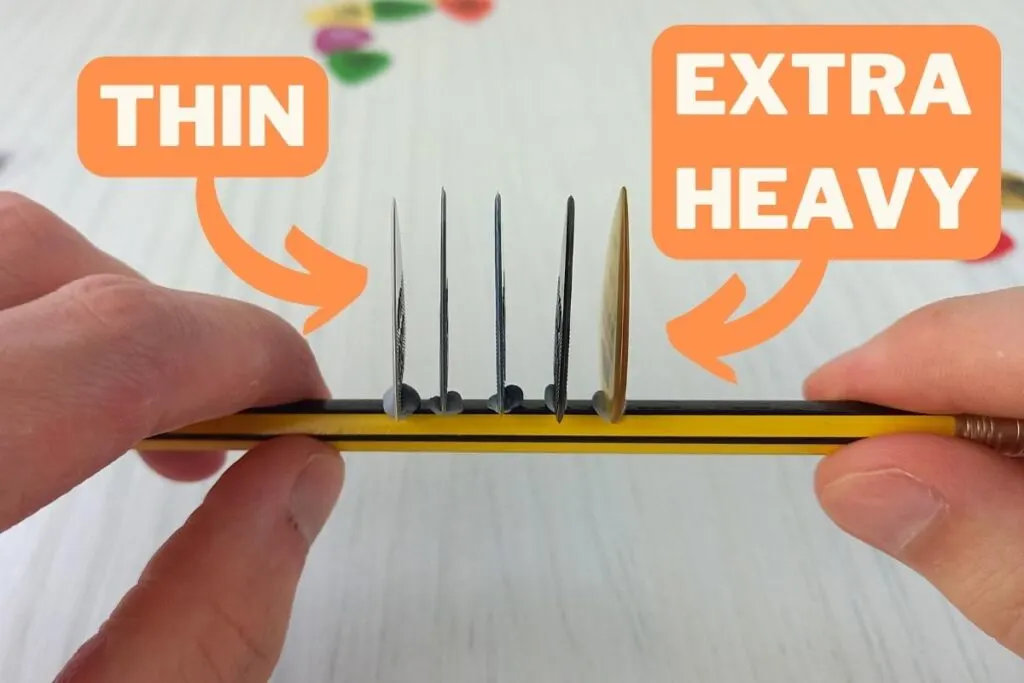
Thin
These are the thinnest type of guitar picks and measure less than 0.6mm thick. They have the advantages of being light, flexible, and easy to handle. Generally speaking, a thinner guitar pick will make a guitar sound “brighter”.
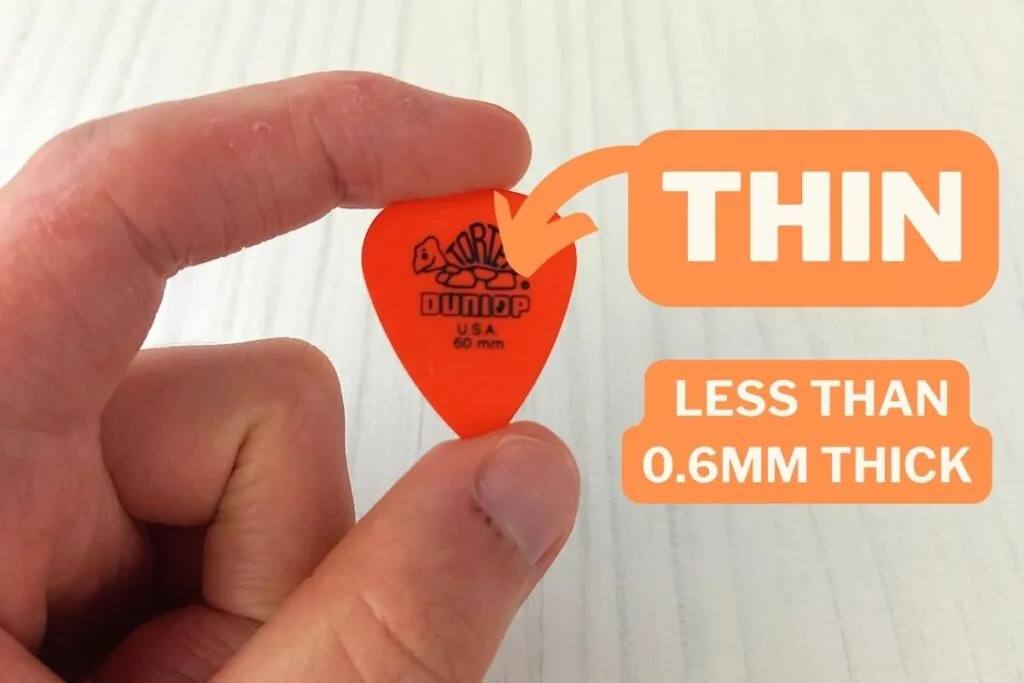
This type of pick is great for strumming, and sounds great on an acoustic guitar. The brightness of the sound can really bring an acoustic guitar to life. Also, the flexibility of the pick means that there’s less resistance from the string when strumming, which means less work for your wrist and arm!
The downside to these picks is that they can sound too bright for lead guitar playing. Likewise, their flexibility can make them less accurate for individual string picking, in my experience.
In my opinion, these picks are best for playing acoustic guitars. For electric guitar and bass, I’d recommend using a thicker pick.
Medium
Medium picks measure between 0.6mm and 0.8mm. This is the most common thickness that players use, especially beginner guitarists who are just learning how to use a guitar pick. Medium picks are a good middle-ground between thin and thick picks, with the advantages of both.
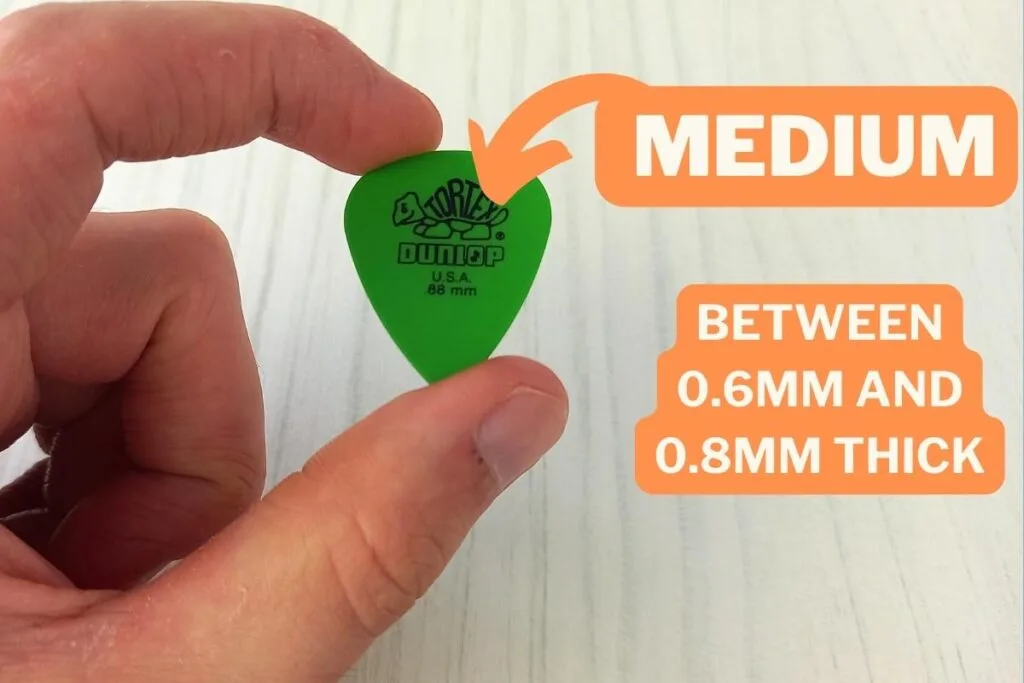
These picks have some flexibility, so they are still easy to use, but they’re also sturdier than thin picks. This makes them better at picking individual notes. They also sound bright, but have more mid and bass tones compared to thinner picks. In my opinion, this gives them a better, well-rounded sound.
The downside to these picks is that they are the middle-ground. If you want a brighter sounding pick, you’ll need to go thinner. If you want a sturdier, bassier sounding pick, then you’ll need to go thicker.
Still, these are a great pick for beginners to get started with, and are used by many professional guitarists.
Read more: Best Guitar Picks for Beginners (2022)
Heavy
Heavy picks measure between 0.8mm and 1.2mm. These picks can be more challenging to handle, but they offer better control compared to thin or medium picks.
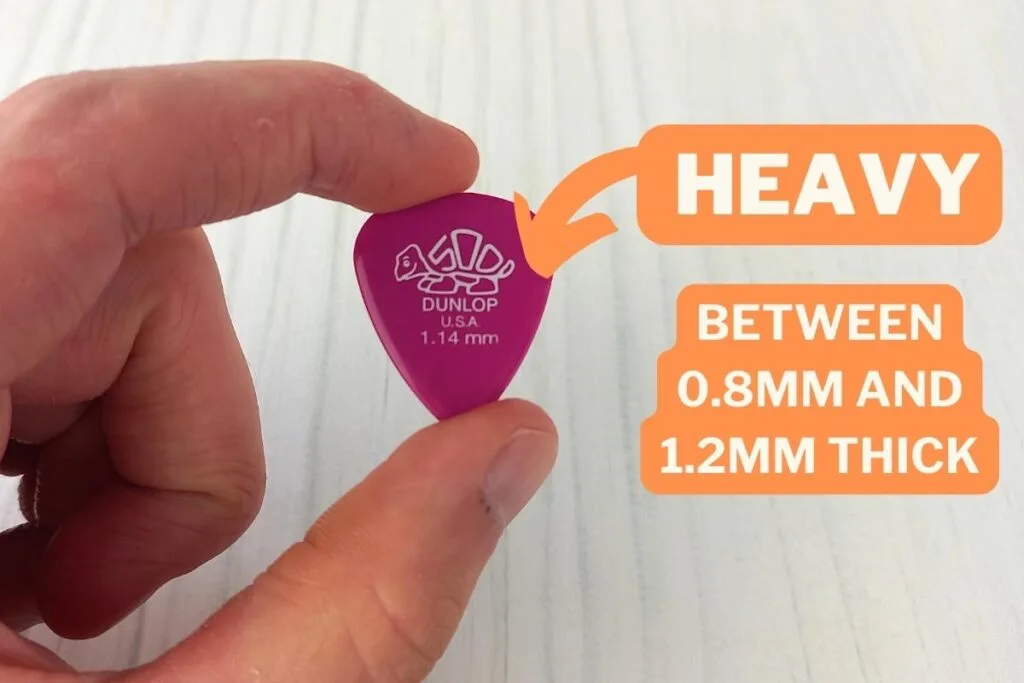
These picks are a lot harder to bend, so they apply more pressure to the strings. This is great for lead guitarists and heavy rhythm players. Their rigidity makes them great for picking individual strings, and faster picking styles such as sweep and economy picking.
Overall, these picks produce more mid and bass tones compared with thinner picks, which makes them better suited to electric guitar and bass than acoustic guitars. They can also be a bit harder to handle if you’re not used to them!
These are the type of guitar picks that I use and recommend to most people. I find that I’m a lot more accurate with them, and that my guitar sounds warmer.
Extra Heavy
Extra heavy picks are picks that are thicker than 1.2mm. This type of pick is a lot less common than the other types. They’re often used by guitarists looking for a warmer tone from their guitar. They’re a great choice for metal guitarists, jazz players, and bassists. I’d recommend avoiding these unless you have a specific need for them!
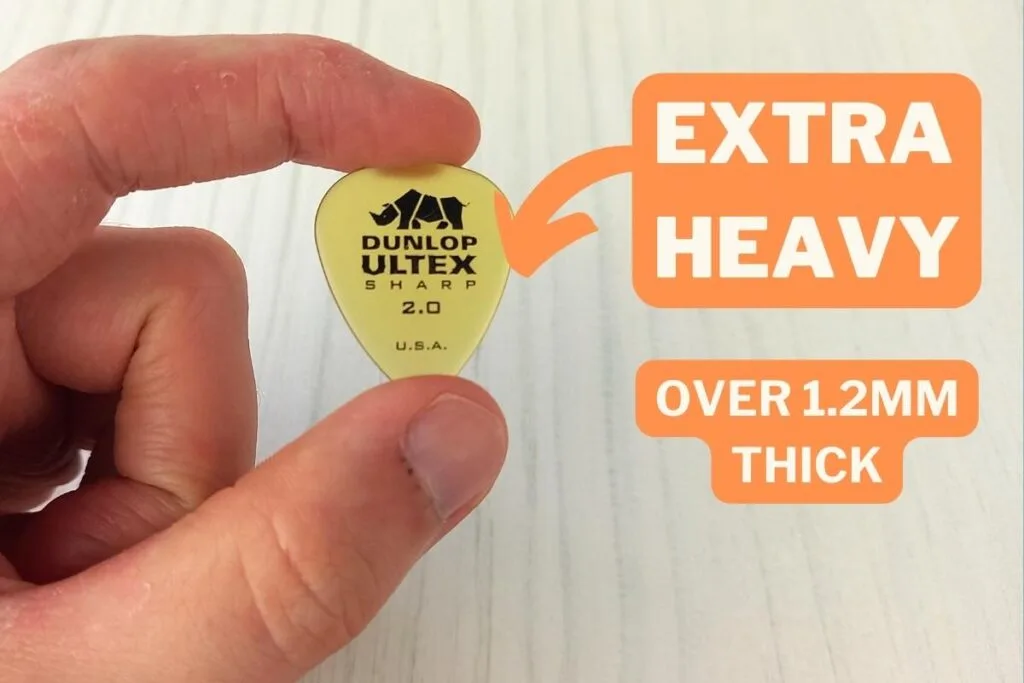
What are the different guitar pick thicknesses used for?
There are no real rules for when to use thinner or thinner picks. Just use what sounds good and what feels right for you. That being said, here are a couple of guidelines you can follow if you’re in doubt.
Thin and Medium picks
In my opinion, thin and medium guitar picks are best used for the following scenarios:
- Brighter notes: Since the pick’s surface is much thinner than others, it produces more treble frequencies, leading to brighter tones. This is great for acoustic guitar or rhythm parts that need to cut through a mix.
- Strumming: A thinner pick is the ideal strumming pick since the slight flexibility and smaller playing surface help to accentuate each string more clearly, which makes the entire chord sound fuller. It’s also easier on your wrist, as there’s less resistance from the strings.
Heavy and Extra Heavy picks
A thicker pick is more challenging to handle, and you require more strength to grip it tightly to maintain control. But there are specific scenarios where a thicker pick is the better choice:
- Heavy distortion: The distorted power chords popular with hard rock and metal should ideally be played with a thicker guitar pick. The wider playing surface helps to bring out more mid and bass tones from the strings.
- Lead guitar: Having less flexibility allows for more control as you’re playing, which means you can pick strings with more precision. That’s why I recommend playing lead guitar with a thicker guitar pick.
- Mellow tones: As mentioned with the distortion, the thickness of the pick lends itself to deeper, more bass-driven sounds. But it’s not just for use with a distorted guitar. Thicker picks are great for playing styles that need a warmer tone, like jazz and blues.
Guitar pick materials
The material used for a guitar pick makes just as much difference as its thickness. Different materials lead to different qualities, so it’s essential to choose the right kind of material that works for you.
Here are some of the ways the material can make a difference:
- Texture: Though texture is something that can be added later in the manufacturing process, some materials naturally have a rougher texture than others. A pick made from a coarser material may be easier to grip, but could also get uncomfortable to use after a while. Likewise, texture plays a large role in the tone that you’ll get from a guitar pick.
- Weight: Some materials weigh more than others, which also means that some picks may be more challenging to handle than others. For example, an extra thick pick made from metal would be very heavy and more difficult to control.
- Flexibility: Some materials make picks more flexible than others, even at higher thicknesses. As we’ve seen, flexible picks are generally better for strumming than for picking. More rigid picks are more ideally suited to picking and lead electric guitar.
The most common materials used for guitar picks
Here’s a list of the materials most commonly used to make guitar picks:
Celluloid

Celluloid is a synthetic material that was designed in the early 1900s to as an alternative to tortoise-shell. These guitar picks are instantly recognisable by their marbled look, usually using red and brown colors to mimic natural tortoise-shell. They’re usually flexible, and are good for producing a natural and warm sound from your guitar. Unfortunately, celluloid isn’t that strong, so you may find yourself going through these picks quite quickly.
Celluloid picks are arguably the most popular picks on the market today, standing the test of time as one of the oldest synthetic materials used for manufacturing guitar picks.
Nylon
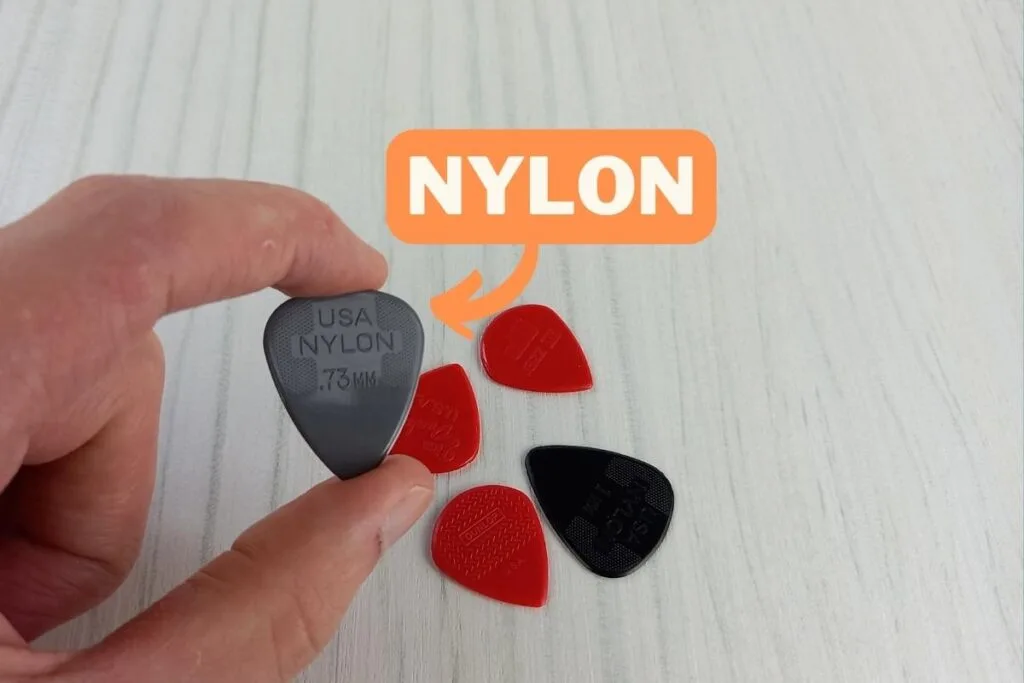
Nylon is another synthetic material used for guitar picks. They produce a warm sound that’s similar to that of celluloid picks, but I find that nylon picks are a lot more durable! My favorite guitar pick, the Dunlop Jazz III, is nylon and they last for a good amount of time.
Nylon picks are usually more rigid than celluloid, but are still quite flexible. They also usually come with textured surfaces that make them easier to hold and control!
Delrin (Tortex)

Delrin, more commonly known as the brand name “Tortex”, is a type of material made from acetal and is designed to mimic the natural sound and feel of tortoise-shell. These picks are synonymous with Dunlop’s Tortex range of guitar picks, which are used by beginners and professionals alike. This material provides a firm grip while not being too rough, so it’s suitable for long playing periods. Nowadays, these picks also come with a chalky coating, which further improves the grip!
These picks also last a long time, so they’re worth it despite costing a little bit more than other options.
Ultem
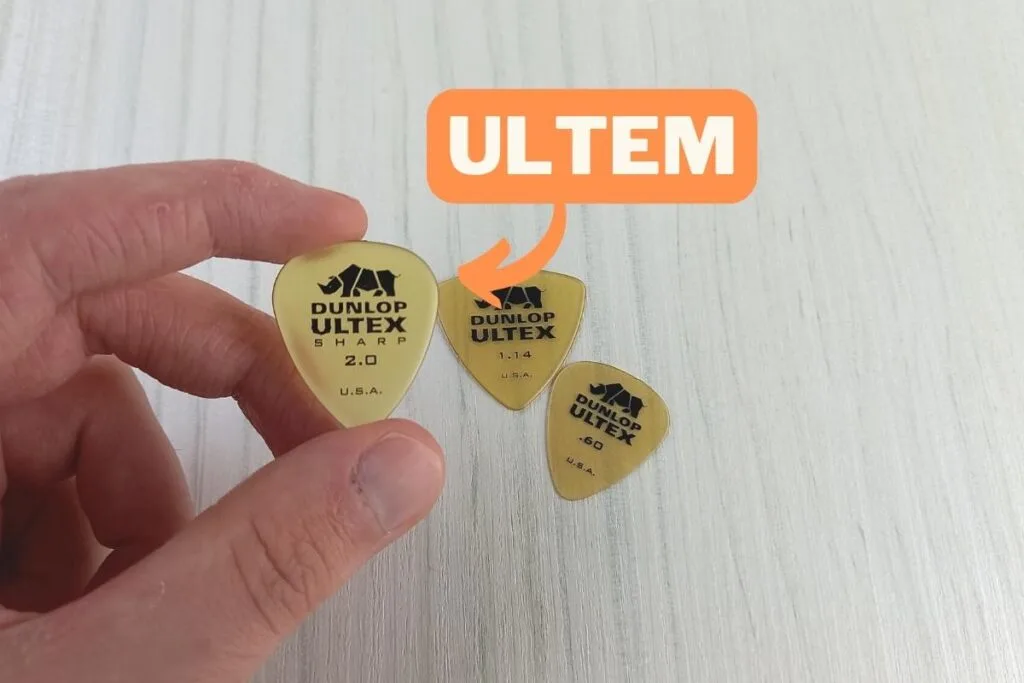
Ultem is a type of plastic that’s strong, durable, and incredibly rigid. The most common example of this pick is Dunlop’s Ultex series of picks. These produce a very bright and crisp sound, especially when compared to the Tortex picks. Ultem picks are sturdy and reliable, but can sound a bit too bright on occasions, in my opinion.
Carbon fiber

Carbon fiber is a bit of a niche material for guitar picks, but it’s very versatile. It creates a bright tone, is very durable and solid but still very light, and these picks are usually easy to grip. Carbon fiber is a great pick material, as it’s well balanced for most style of play and any type of guitar. On the downside, these are usually much more expensive compared to other guitar picks!
Wood
Wooden picks aren’t very common, but some players prefer to use them. The fact that wooden picks are made of the same material as the guitar’s body is very symbolic to some guitarists. Likewise, they can be seen as a more sustainable option compared to the plastics used in other picks. Different types of wood will create different tones, depending on their density. Wooden picks can wear out and break easily, but they are easy to grip and play with. I think they’re a great pick for acoustic guitar, if not just for the aesthetic.
Metal
Some metals, especially stainless steel, are becoming favored for guitar pick-making. Metal picks are solid with very little wear and produce a uniquely bright sound. But they are hard on the strings and will wear them down quickly. They can also scratch your guitar’s body much easier than a regular pick. Personally, I’m not a fan of metal picks. I used one when I was younger, and it sounded way too bright for my liking.
Stone
Some kinds of stone, like Jade, Jasper, and Agate, can make beautiful guitar picks. They’re also solid and very durable. But, like metal picks, there’s a good chance they could scratch your guitar’s body or wear out your strings much faster than usual. They are usually polished and shiny, which could make them more challenging to hold. These are more of a novelty pick than a staple choice.
Guitar pick shapes
At a glance, you might think that all guitar picks look the same – but that’s not the case! Very subtle differences in their shape can make an immeasurable difference in how well you play with a particular pick.
The basic pick shapes are:
Standard
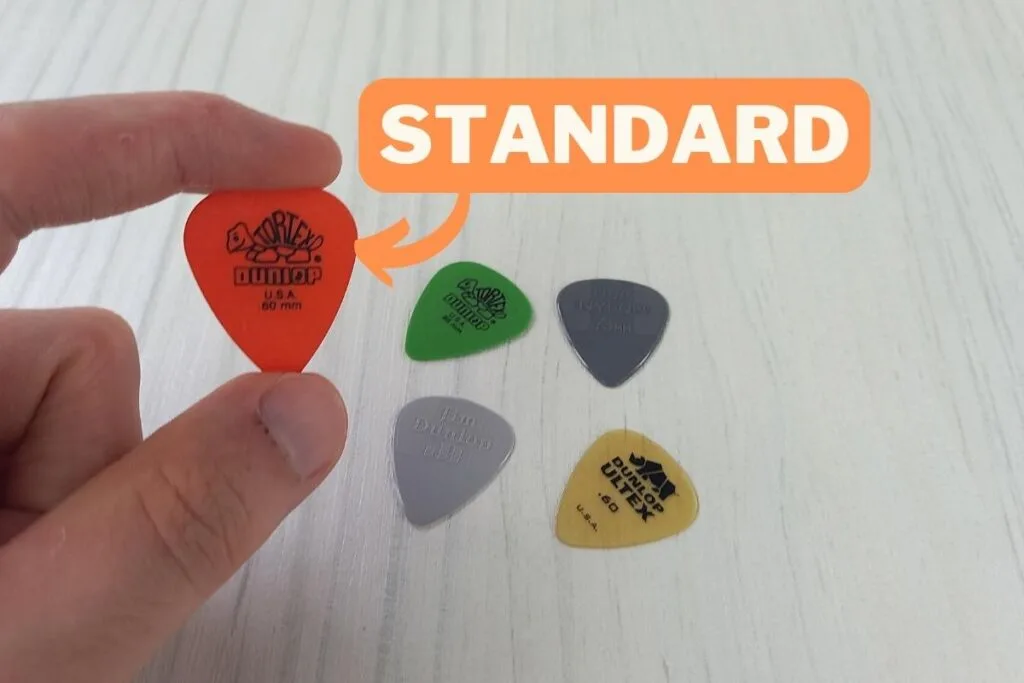
The standard shape is the most commonly used shape of guitar pick. These are ideal general-use picks, offering ease of use for both strumming and picking, making them particularly popular with beginners. The wide gripping surface makes them a great choice for newer guitarists. But, it’s not just beginners: plenty of professionals use standard shaped picks, too. This shape of pick just works. It’s the standard shape for a reason!
Jazz
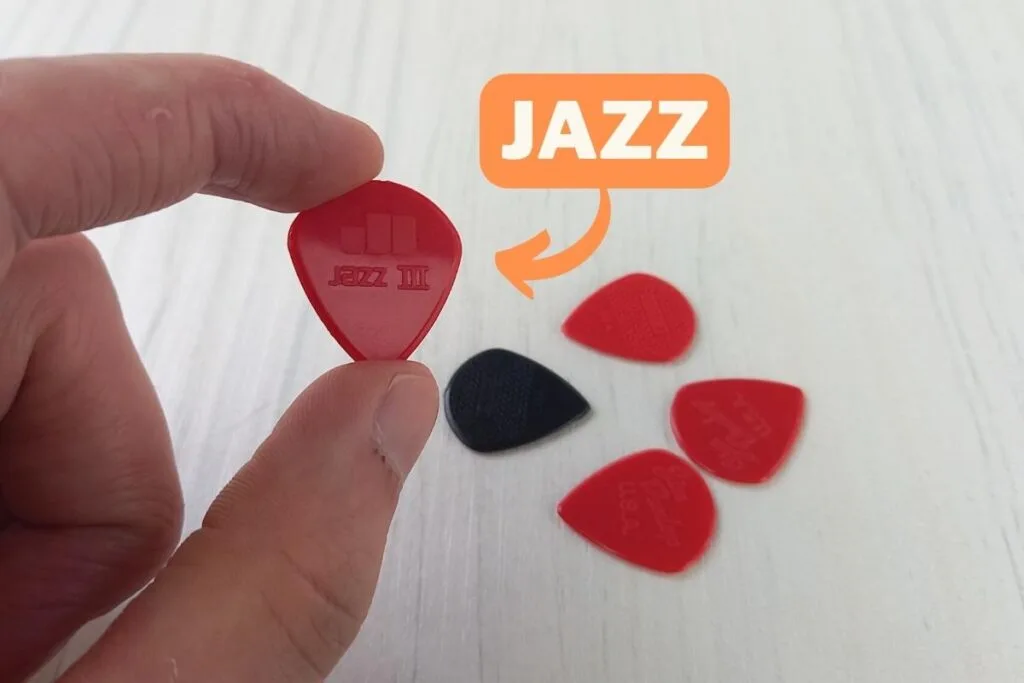
These picks aren’t just for jazz! Jazz picks are smaller than standard sized picks. They’re also usually thicker and with a pointier tip. This makes them great for accurately picking notes, and skipping between strings. Likewise, their thickness means that they produce more mid and bass-heavy tones from a guitar. They also come in a “jumbo” size, which is something of a crossover between a standard and jazz sized pick.
I use the Dunlop Jazz III pick – it’s my go-to pick! I recommend checking it out if you’ve not used one before.
Triangle
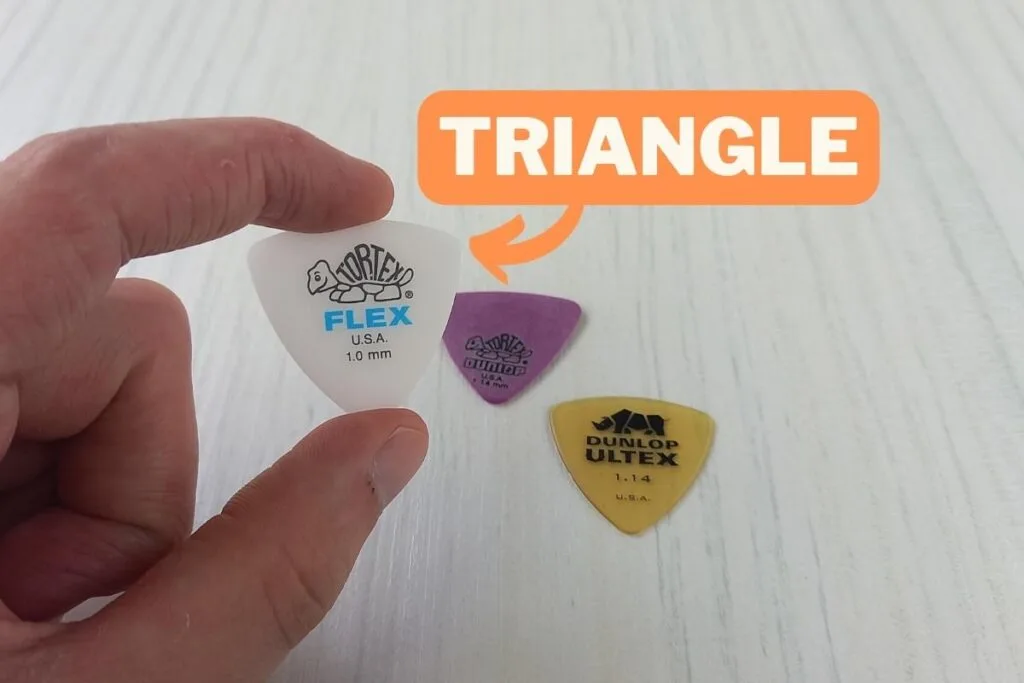
Triangle picks are less common than the previous pick shapes. They’re bigger than most other picks, and the shape is mainly popular with bass and acoustic players. I find that they’re a bit too big for accurate guitar picking, but they’re great for strumming. You can also use all three sides for picking, so you get more mileage out of them!
Teardrop
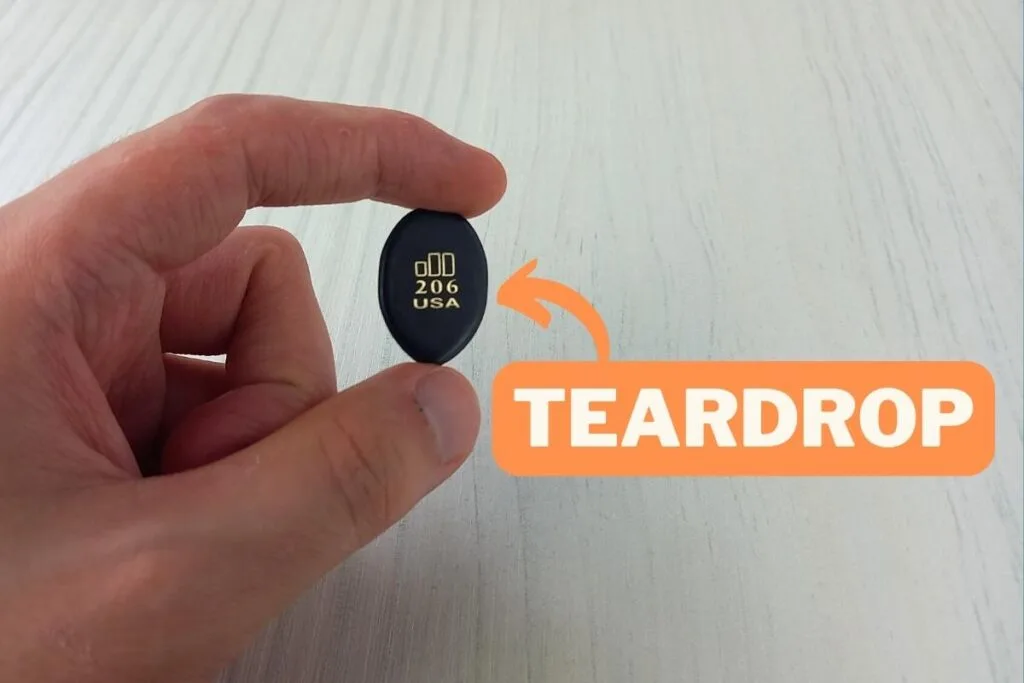
Teardrop picks are similar to the Jazz picks, but with an elongated shape. These picks are great for lead guitarists who need accuracy and speed for solos, but they can be a bit tricky when used for strumming. They’re a bit more niche than the other types of pick, but are worth checking out if you’re looking for a nimble pick to improve your speed (but I’d try out the Jazz pick first!)
Do you really need to use a guitar pick?
A guitar pick is necessary for most electric guitarists. Not only do they make learning guitar easier, but picks also make it easier to play a particular note with accuracy and clarity. A pick adds to the precision of your guitar playing, which is a skill that’s difficult (though not impossible) to master when you don’t use a guitar pick.
However, there are some really great electric guitarists who don’t use a pick. They include legends like Mark Knopfler, Robby Krieger, Lyndsey Buckingham, and Jeff Beck. These are brilliant players who have mastered guitar without using a pick. But, they are definitely the exception to the rule.
I always recommend to use a guitar pick when playing electric guitar.
For acoustic guitar and bass, it’s a different story. Playing “finger-style” on these instruments is much more common, and easier. But, you can still use a guitar with an acoustic guitar or bass, depending on your preferred playing style.
Conclusion
A guitar pick shouldn’t be a “one size fits all” type of thing, and any guitarist who wants to take their playing seriously should put in the time to find the pick that’s perfect for them and their guitar playing style.
I remember when I first tried out the Dunlop Jazz III pick after using the standard sized picks for so many years – it completely blew me away! I found that this pick gave me much better accuracy and made my guitar sound thicker than before. But, I know people that really can’t use them!
With so many variations out there, this could take a while, but it’s well worth it, and the difference that a good pick makes may just surprise you.
If you’re interested in finding the best pick for you, I recommend checking out my other article: the best guitar picks for beginners.
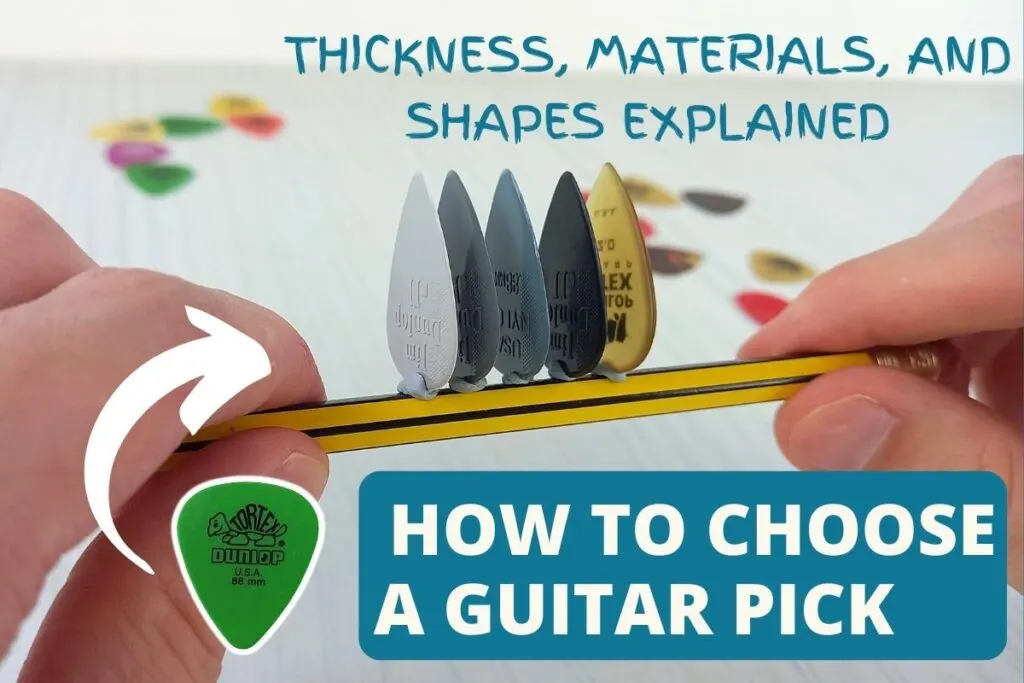

Conor is a music producer, multi-instrumentalist, and all-round enthusiast from the UK with over 15 years of experience. He’s the founder and sole-content creator for the roundtable audio blog and YouTube channel.
